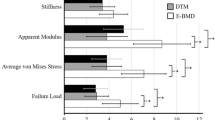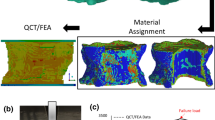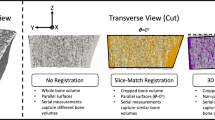Abstract
As more therapies are introduced to treat osteoporosis, precise in vivo methods are needed to monitor response to therapy and to estimate the gains in bone strength that result from treatment. A method for evaluating the strength of the proximal femur was developed and its short term reproducibility, or precision, was determined in vivo. Ten volunteer subjects aged 51–62 years (mean 55.6 years), eight women and two men, were examined using a quantitative computed tomography (QCT) protocol. They were positioned, scanned, re-positioned and re-scanned. The QCT images were registered in three-dimensional space, and finite element (FE) models were generated and processed to simulate a stance phase load configuration. Stiffness was computed from each FE model, and strength was computed using a regression equation between FE stiffness and fracture load for a small set n=6 of experimental specimens. The coefficients of variation (COV) and repeatability (COR=2.23* √2*COV) were determined. The COV for the FE fracture load computed was 1.85%, and the detectable limit (coefficient of repeatability) for serial measurements was 5.85%. That is, if a change of 5.85% or more in computed FE fracture load is observed, it will be too large to be consistent with measurement variation, but instead can be interpreted as a real change in the strength of the bone. The detectable limit of this method makes it suitable for serial research studies on changes in femoral bone strength in vivo. © 2000 Biomedical Engineering Society.
PAC00: 8719Rr, 8759Fm, 8710+e
Similar content being viewed by others
REFERNCES
1_AAPM Report No. 31; standardized methods for measuring diagnostic x-ray exposures. American Institute of Physics, New York, 1990, pp. 15–19.
2_ Ardran, G. M., H. E. Crooks, and R. Birch. Constancy of radiation output during diagnostic x-ray exposures.Br. J. Radiol.51:867-874, 1978.
3_ Black, D. M., S. R. Cummings, D. B. Karpf, J. A. Cauley, D. E. Thompson, M. C. Nevitt, D. C. Bauer, H. K. Genant, W. L. Haskell, R. Marcue, S. M. Ott, J. C. Torner, S. A. Quandt, T. F. Reiss, and K. E. Ensrud. Randomised trial of effect of alendronate on risk of fractures in women with existing vertebral fractures.Lancet348:1535-1541, 1996.
4_ Chinn, S.The assessment of methods of measurement.Stat. Med.9:351-362, 1990.
5_ Cody, D. D., F. J. Hou, G. W. Divine, and D. P. Fyhrie. Femoral structure and stiffness in patients with femoral neck fractures. J. Orthop. Res. (to be published).
6_ Cody, D. D., D. A. McCubbrey, G. W. Divine, G. J. Gross, and S. A. Goldstein. Predictive value of proximal femoral bone densitometry in determining local orthogonal material properties.J. Biomech.29:753-761, 1996.
7_ Cody, D. D., G. J. Gross, F. J. Hou, H. J. Spencer, S. A. Goldstein, and D. P. Fyhrie. Femoral strength is better predicted by finite element models than by QCT or DXA.J. Biomech.32:1013-1020, 1999.
8_ Cummings, S. R., D. M. Black, D. E. Thompson, W. B. Applegate, E. Barrett-Connor, T. A. Musliner, L. Palermo, R. Prineas, S. M. Rubin, J. C. Scott, T. Vogt, R. Wallace, A. J. Yates, and A. Z. LaCroix. Effect of alendronate of risk of fracture in women with low bone density but without vertebral fractures.J. Am. Med. Assoc.280(24):2077-2082, 1998.
9_ Deboeuf, F., D. Hans, A. M. Schott, P. O. Kotzki, F. Favier, C. Marcelli, P. J. Meunier, and P. D. Delmas. Different morphometric and densitometric parameters predict cervical and trochanteric hip fracture: The EPIDOS study.J. Bone Min. Res.12:1895-1902, 1997.
10_ Ensrud, K. E., D. M. Black, L. Palermo, D. C. Bauer, E. Barrett-Connor, S. A. Quandt, D. E. Thompson, and D. B. Karpf. Treatment with alendronate prevents fractures in women at highest risk.Arch. Int. Med.157:2617-2624, 1997.
11_ Flynn, M. J., J. Li, and D. D. Cody. Interactive alignment and subtraction of two tomographic 3D imaging studies.Proc. SPIE1898:870-878, 1993.
12_ Gluer, C. C., G. Blake, Y. Lu, B. A. Blunt, M. Jergas, and H. K. Genant. Accurate assessment of precision errors: How to measure the reproducibility of bone densitometry techniques.Osteoporosis Int.5:262-270, 1995.
13_ Greenspan, S. L., E. R. Myers, L. A. Maitland, N. M. Resnick, and W. C. Hayes. Fall severity and bone mineral density as risk factors for hip fracture in ambulatory elderly.J. Am. Med. Assoc.271:128-133, 1994.
14_ Hirsch, C. and V. H. Frankel. Analysis of forces producing fractures of the proximal end of the femur.J. Bone Jt. Surg., Br. Vol.42:633-640, 1960.
15_ Hou, F. J., S. M. Lang, S. J. Hoshaw, D. A. Reimann, and D. P. Fyhrie. Human vertebral body apparent and hard tissue stiffness.J. Biomech.31:1009-1015, 1998.
16_ Karpf, D. B., D. R. Shapiro, E. Seeman, K. Ensrud, C. C. Johnston, S. Adami, S. T. Harris, A. C. Santora, L. J. Hirsch, L. Oppenheimer, and D. Thompson. Prevention of nonvertebral fractures by alendronate: A meta-analysis.J. Am. Med. Assoc.277:1159-1164, 1997.
17_ Kaufer, H., L. S. Matthews, and D. Sonstegard. Stable fixation of the intertrochanteric fracture.J. Bone Jt. Surg., Am.56:899-907, 1974.
18_ Keyak, J. H., M. G. Fourkas, J. M. Meagher, and H. B. Skinner. Validation of an automated method of three-dimensional finite element modeling of bone.J. Biomed. Eng.15:505-509, 1993.
19_ Keyak, J. H., J. M. Meagher, H. B. Skinner, and C. D. Mote. Automated three-dimensional finite element modeling of bone: A new method.J. Biomed. Eng.12:389-397, 1990.
20_ Keyak, J. H., S. A. Rossi, K. A. Jones, and H. B. Skinner. Prediction of femoral fracture load using automated finite element modeling.J. Biomech.31:125-133, 1998.
21_ Lang, T. F., J. H. Keyak, M. W. Heitz, P. Augat, Y. Lu, A. Mathur, and H. K. Genant. Volumetric quantitative computed tomography of the proximal femur: Precision and relation to bone strength.Bone (N.Y.)21:101-108, 1997.
22_ Liberman, U. A., S. R. Weiss, J. Broll, H. W. Minne, H. Quan, N. H. Bell, J. Rodriguez-Portales, R. W. Downs, J. Dequeker, M. Favus, E. Seeman, R. R. Recker, T. Capizzi, A. C. Santora, A. Lombardi, R. V. Shah, L. J. Hirsch, and D. B. Karpf. Effect of oral alendronate on bone mineral density and the incidence of fractures in postmenopausal osteoporosis.N. Engl. J. Med.333:1437-1443, 1995.
23_ Lotz, J. C., E. J. Cheal, and W. C. Hayes. Fracture prediction for the proximal femur using finite element models: Part I—Linear analysis.J. Biomech. Eng.113:353-360, 1991.
24_ Lotz, J. C., E. J. Cheal, and W. C. Hayes. Stress distributions within the proximal femur during gait and falls: Implications for osteoporotic fracture.Osteoporosis Int.5:252-261, 1995.
25_ McClung, M. R.Current bone mineral density data on bisphosphonates in postmenopausal osteoporosis.Bone (N.Y.)19:195S-198S, 1996.
26_ Orr, T. E., G. S. Beaupre, D. R. Carter, and D. J. Schurman. Computer predictions of bone remodeling around porous-coated implants.J. Arthroplasty5:191-200, 1990.
27_ Peacock, M., C. H. Turner, G. Liu, A. K. Manatunga, L. Timmerman, and C. C. Johnston. Better discrimination of hip fracture using bone density, geometry and architecture.Osteoporosis Int.5:167-173, 1995.
28_ Smith, M. D., D. D. Cody, N. M. Cooperman, S. A. Goldstein, L. S. Matthews, and M. J. Flynn. Proximal femur bone density and its correlation to fracture load and hip screw penetration load.Clin. Orthop. Relat. Res.283:244-251, 1992.
Author information
Authors and Affiliations
Rights and permissions
About this article
Cite this article
Cody, D.D., Hou, F.J., Divine, G.W. et al. Short Term In Vivo Precision of Proximal Femoral Finite Element Modeling. Annals of Biomedical Engineering 28, 408–414 (2000). https://doi.org/10.1114/1.278
Issue Date:
DOI: https://doi.org/10.1114/1.278




